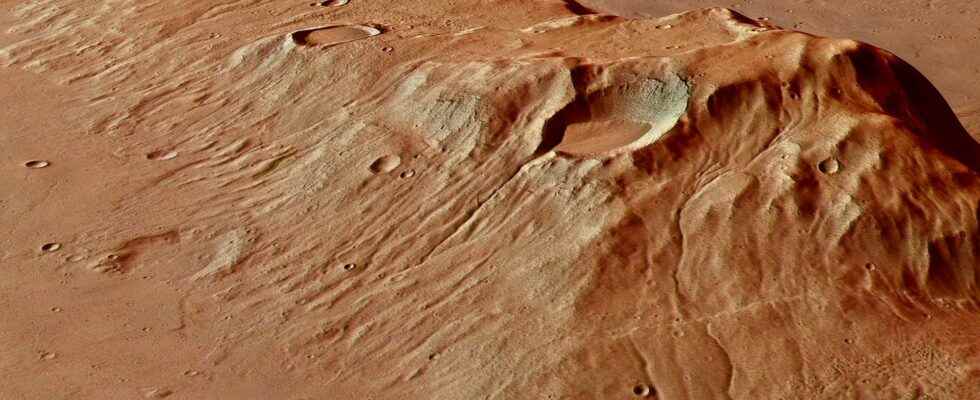You will also be interested
[EN VIDÉO] Mars, the Red Planet soon within human reach For more than half a century, humans have been exploring Mars, Earth’s little sister with a tragic destiny. This long saga of missions is told to us here, showing how the face of the Red Planet took shape. The fantasies of yesteryear were succeeded by the disappointment at first sight, in 1965. The renewed interest returned in the face of the evidence of a turbulent history, as we like them. Secrets, enigmas and mysteries await us there, now that the idea of a new human adventure on this world so close is taking shape.
On Mars, the surface of the ground is marked in many places by traces of flows of fluid material. These traces, which extend over several kilometres, are generally interpreted as markers of lavasby analogy with what can be observed on Earth. However, some observations open the door to other assumptions.
Volcanoes, but no lava
The study of morphology of certain flows present in particular at the level of the southern margin of Chryse Planitia, indeed suggests that their origin could be different. Although they are associated with domed buildings, a characteristic shape for volcanoes, several morphological elements suggest that they are not lava flows, nor “classic” volcanoes. Some flows are in fact characterized by a central depression forming a system of channels bordered by levees and ending gradually. These observations suggest that it could be mudslides of volcanic origin.
In a new study, published in Icarus, researchers provide additional evidence for this hypothesis, based on terrain elevation models. These data, acquired by the HiRISE camera from the Mars Reconnaissance Orbiter space probe, confirm that these channels were formed by the transport of liquid material, rich in mud, associated with a volcanism sedimentary. This type of “volcanism” is well known on Earth. In this case, the volcanoes do not emit lava, but mud or sand heavily loaded with water. This fluid mixture will flow along the slopes, forming channels with a characteristic relief.
A way to study the composition of the Martian subsoil
The observation, moreover quite frequent, of this type of process on Mars is particularly interesting since it allows the bringing to the surface of sediment of deep origin. The Chryse Planitia deposits could thus be very good candidates for future exploration sites. Their study could make it possible to analyze, indirectly, the composition of the Martian subsoil and its variability. They could also represent an interest in the search for biological traces on Mars.
On Mars, mud flows like lava
To find out what certain Martian landforms are made of, an international research team involving Susan Conway, CNRS researcher at the Laboratory of Planetology and Geodynamics (CNRS/University of Nantes/University of Angers), simulated mudslides on Mars and on Earth. . As a result, Martian landforms that look like solidified lava, like those found in Hawaii, are actually mud that behaves differently from terrestrial mud.
Article of Remy Decourt published on May 23, 2020
An international research team involving Susan Conway, CNRS researcher at the Laboratory of Planetology and Geodynamics (CNRS/University of Nantes/University of Angers) decided to study Martian reliefs whose composition is poorly known and subject to debate. This is particularly the case of the plains of Cerberus Fossae that some researchers have interpreted as coming from lava and others as mud or still others as an icy sea », explains Susan Conway.
To understand how a mixture of rock and water would behave once in the open air on the Red Planet, the researchers ” reproduced in the laboratory the Martian conditions in a low pressure chamber and observed the flow of this mud “. With a atmospheric pressure 150 times weaker than ours, and most often negative temperatures, its “ behavior was very different from terrestrial muds “. While mud on Earth boils at 100°C at sea level and 70°C at the summit of Everest, on Mars it ” boils all the time due to the very low density of theatmosphere martian !
Scientists have simulated mudslides on Mars and on Earth. © Lancaster University, YouTube
Experience shows that the mud ” then behaves in the same way as some terrestrial lava flows and can form many folds, called pahoehoe “. Indeed, when ” our experience the mud boiled over (even though it was near zero degrees) and then started to freeze “. It is the combination of freeze and the boiling that drove the mud to ” make shapes that look like solidified lava “.
These results published in Nature Geoscience, on May 18, 2020, therefore suggest that “ the sedimentary volcanism can manifest on Mars, that is, a geological phenomenon that would lead to the eruption of mud from the Martian subsoil “. They also invite the community to review any Martian geological structures that may have been formed by this phenomenon “.
Fossils of early life trapped in solidified Martian mud
This discovery is important because each ” interpretation has very different consequences for our understanding of Mars’ environment and its habitability. “. Finally, as Susan Conway points out, it is possible to establish a link between this mud and the habitability of the planet »? If the presence of mud can explain the ” presence of more shapes on the surface than originally thought “, this implies that there was, perhaps even today, a ” underground water tank (instead of a Magma chamber) which would be more conducive to life than lava !
Today, this solidified mud could ” shelter fossils primitive lives “, so that a certain number of these sites are to be privileged for the future missions in search of the signs of life on Mars.
Interested in what you just read?
